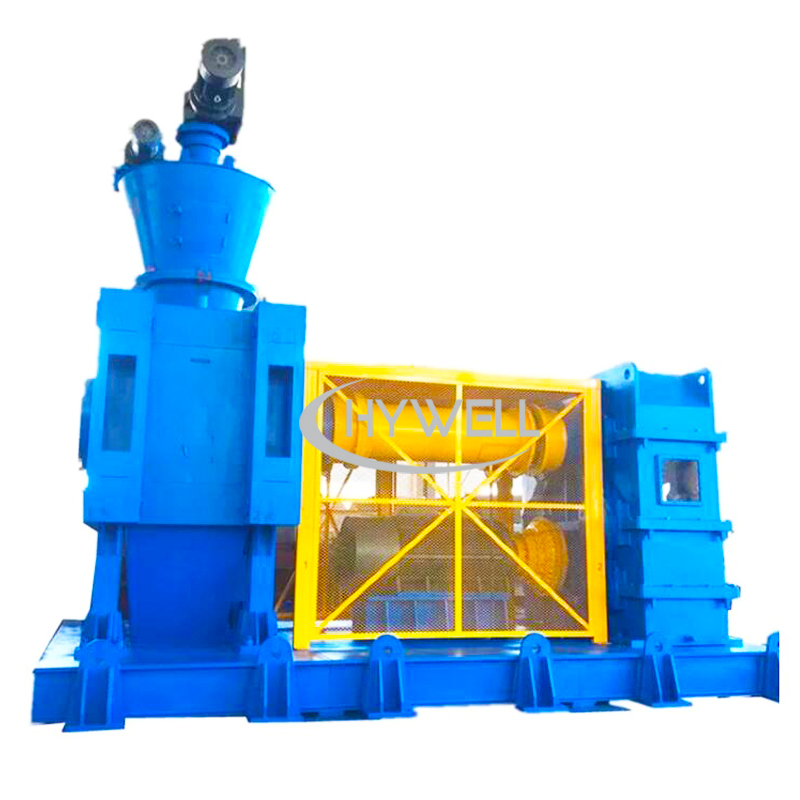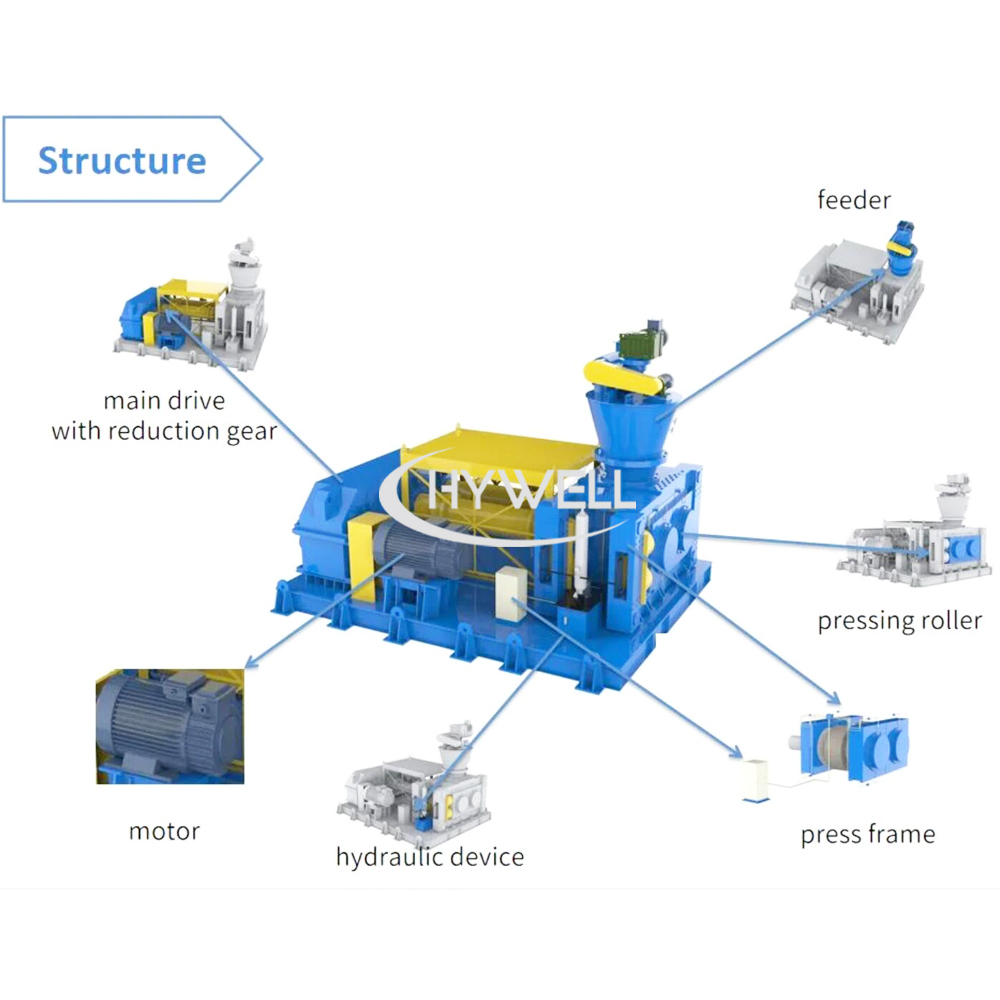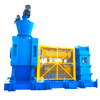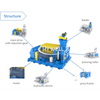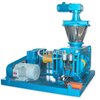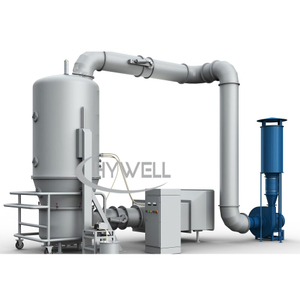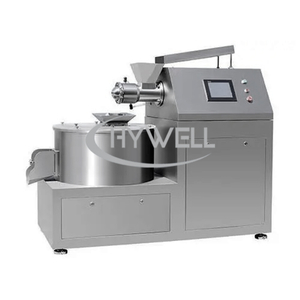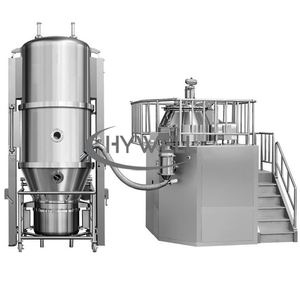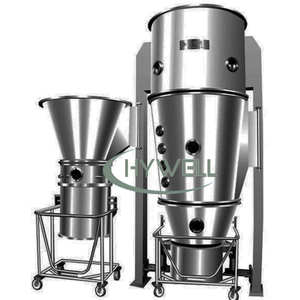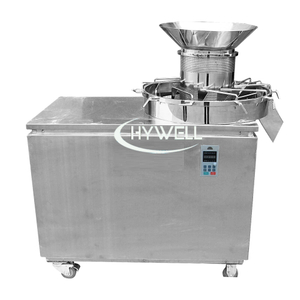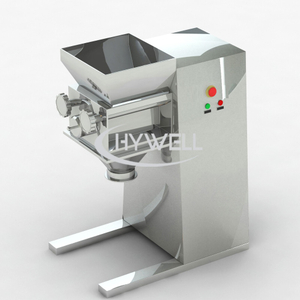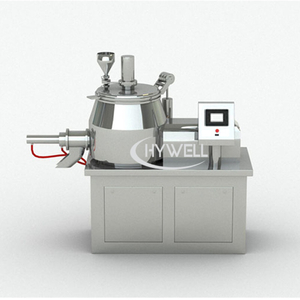Overview of roller compactor granulator
There are generally two types of powder granulation technologies: wet and dry granulation. The dry granulator method involves extruding the product into agglomerates or sheets without adding a binder and then crushing and screening it into dry granular products. Wet methods mainly use rollers, discs, melting, spraying, and spraying to granulate.
Wet granulator
In wet granulation, the wet strength generated by the capillary effect of the liquid binder plays a vital role. In the
subsequent drying stage, the chemical reaction between the components and the crystallization of the dissolved substances produce solid, Crystal bridges that give shape to the particles. Representative equipment of this technology includes fluid bed granulator, high shear granulator, rollers, fluidization devices, etc.
Roller compactor granulator
Binder-free dry extrusion granulation technology is a very competitive technology. In general, particles are not formed by solid bridges between particles, but by the strength of particles formed by the forces between molecules. Due to the short distance of this force, the particles are required to be similar in size, and external pressure is required. The method of pressurization can be extrusion (pressing the material with holes with a fixed diameter) or extrusion (pressurizing both sides of the material), if the extrusion occurs in the gap between two counter-rotating rollers, the process is a roller compaction granulator. The DG series roller compactor granulator uses dry roller pressing technology to compress powdery materials with a moisture content of ≤5% into flakes or blocks and then undergoes crushing, granulation, and screening processes to make the flakes into lumps. The material becomes granular material that meets the usage requirements. The roller compactor granulator machine mainly relies on external pressure to force the material through the gap between two relatively rotating rollers and force it to be compressed into pieces. During the rolling process, the actual density of the material can be increased by 1.5 to 3 times. In order to achieve certain particle strength requirements.
DG series roller compactor granulator is also called granulator, gypsum briquette machine, briquette machine, carbon black granulator, potassium sulfate granulator, and potassium chloride granulator according to its main use scope.
DG series roller compactor granulator is also called dry granulator, roller granulator, double roller granulator, roller press granulator, and dry granulation machine according to its working properties.

Roller Compactor Granulator

Roller Compactor Granulator
Roller compactor granulator application scope
1.Roller compactor granulator machine for fertilizer
The granulated fertilizer has good physical properties; it can reduce a certain amount of space and cost in logistics; it does not cause dust during loading and unloading, does not agglomerate during long-term storage, has good fluidity, and is easy to spread during fertilization; it can also play a slow-release role to improve fertilizer quality. Utilization rate and enhanced fertilizer efficiency. In addition, granular fertilizers of different varieties but similar sizes can be directly blended to obtain a low-cost compound fertilizer with the same fertilizer effect as compound fertilizer.
However, the only disadvantage of dry roller granulation of chemical fertilizers to produce granular fertilizers is that the shape of the product is irregular particles. However, the irregular particle shape has no impact on the application of chemical fertilizers, and the trimming process can be added to further round the particles. The fertilizer produced by the roller compactor dry granulator has sufficient strength, less dust, no agglomeration, a narrow particle size distribution range, and good fluidity. Fertilizer produced by roller extrusion granulation has been widely used in mechanical fertilization abroad, proving that their particle shape will not be a factor affecting the application of chemical fertilizers.
(1). Single fertilizer roller compaction granulator
Single fertilizer mainly refers to potassium sulfate, potassium chloride, double superphosphate, phosphate rock powder, ammonia sulfate, ammonium chloride, potassium nitrate, and other powders. The purpose of dry granulation is to obtain 1~5 or 2~4mm strong fertilizer particles that are suitable for mechanical fertilization. Therefore, the fertilizer industry also calls dry roller granulators the potassium sulfate granulator, potassium chloride granulator, ammonia sulfate granulator, and ammonium chloride granulator.
Technical features of the dry powder granulator
If the fineness of the powder is between 200 and 400 mesh, it contains a lot of air because the powder is too fine, and the smaller the bulk density. Then the double roller press granulator needs to add a degassing device to achieve successful granulation.
(2) Nitrogen, phosphorus, and potassium compound fertilizer roller compactor granulator
The conventional granulation process of compound fertilizers adopts the wet method. This method requires the wet single raw materials to be mixed and granulated first and then dried. The energy consumption is high. Most of the energy is used in the drying system, and only a small part is used. Suitable for crushing and transporting oversized particles. For wet processes, the drying process is very critical because the moisture inside the particles needs to be dried out. The dry rolling method is used to produce compound fertilizer, which avoids the expensive process of drying. The fertilizer industry also calls the roller compaction granulator an NPK granulator and compound fertilizer granulator. Its advantages: ① Reduce production costs and energy consumption; ② Can be very flexible to produce various formula compound fertilizers; ③ High particle strength.
Technical features of NPK dry granulation
The principle of producing compound fertilizer by dry roller pressing is roughly the same as that of producing a single fertilizer, but the dry granulation of compound fertilizer has its particularities. The main reason is that there is nitrogen fertilizer in the compound fertilizer. For example: Urea has a low melting point and is very hygroscopic. Superphosphate tends to change when stressed. When the content of these two ingredients in the compound fertilizer formula is large, it will have a very adverse impact on the granulation of the compound fertilizer. Therefore, the mixing ratio of nitrogen, phosphorus, and potassium is a very important factor in the nitrogen, phosphorus, and potassium granulator production line.
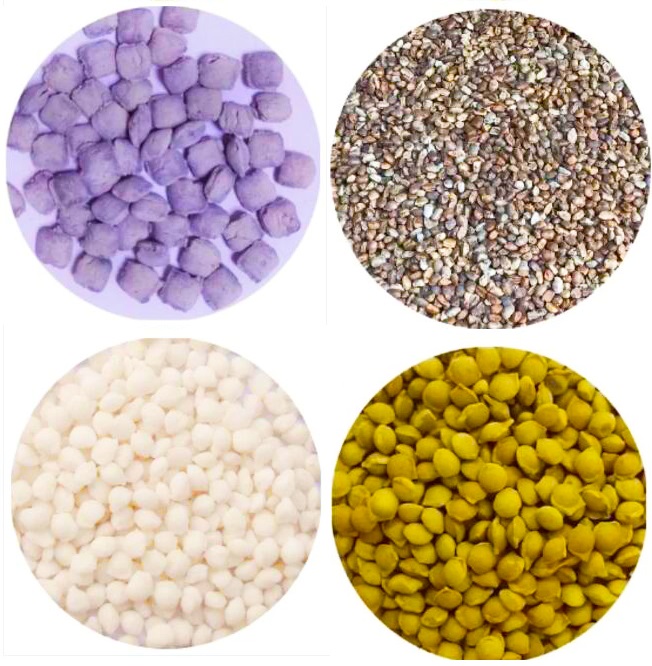
Roller Compactor Granulation

Roller Compactor Granulation
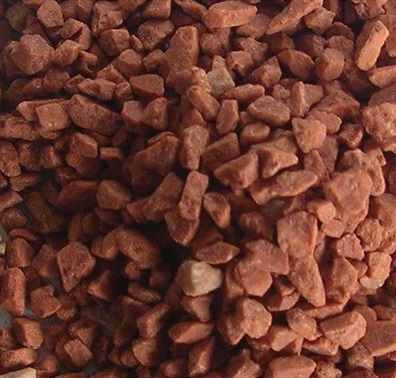
Roller Compactor Granulation
2. Dry granulating machine for fly ash granulation
Fly ash is a volcanic ash material. It has the advantages of high potential activity, good chemical stability of mineral bodies, fine particles, and few harmful substances, and can improve the physical properties of concrete or mortar. Due to the physical properties of coal, pulverized coal is basically insoluble in water, and the pulverized coal particles are very fine and the intermolecular force distance is short, which makes pulverized coal granulation very difficult. A binder needs to be added, and the binder for pulverized coal granulation is coal tar.
The pulverized coal granulator mainly produces two types of pulverized coal: 8-50mm briquettes and 2-6mm activated carbon.
Double Roller Compactor Granulator for 8-50mm briquettes
Dry press granulation presses the pulverized coal into shaped coal, and the range of the shaped coal blocks is 8~50mm, or even larger.
Double Roller Compactor Granulator for 2-6mm activated carbon.
The advantage of producing activated carbon by forming pulverized coal into a certain range of particles is that it increases the porosity and specific surface area, thus greatly improving the adsorption capacity of activated carbon. Therefore, we often form pulverized coal into irregular particles in the range of 2~6mm and then activate it to produce activated carbon and use it as metallurgical raw materials.
3.Roller Compactor Granulator for Fine chemicals and chemical raw material
Environmental protection requirements are getting higher and higher. In order to meet environmental protection requirements, many chemical production companies improve the operating environment of workers and reduce dust pollution. At the same time, in downstream industries related to fine chemicals such as machinery, electronics, automobiles, construction, and information, it has also become an industry development trend to granulate chemical products, such as various additives, antioxidants, and combustion accelerants made after dry granulation desiccants, snow-melting agents, and metallurgical additives have been widely used.
For example antioxidants, sodium cyanide, sodium, cyanuric acid, zinc oxide, lead oxide, potassium carbonate, strontium carbonate, calcium chloride, calcium hydrogen phosphate, sodium metasilicate, Cryolite, aluminum fluoride, white carbon black, calcium aluminate, carnallite, phosphate rock powder, etc.
4. Roller granulator produces different material output
Materials name | Machine model | Particle size(mm) | Output(Kg/h) |
Potassium chloride | DG360,DG450,DG650,DG850 | 2-5 | 1000-1400,2000-2500,3000-4300,5500-7500 |
Potassium sulfate | DG360,DG450,DG650,DG850 | 2-5 | 1000-1300,2000-2500,3000-4300,5500-7500 |
NPK compound fertilizer | DG360,DG450,DG650,DG850 | 2-5 | 900-1400,1800-2500,3000-4300,5500-7500 |
Cryolite | DG360,DG450,DG650,DG850 | 2-5 | 1000-1400,2000-2500,3000-4300,5500-7500 |
Ammonium chloride, ammonium sulfate | DG360,DG450,DG650,DG850 | 2-5 | 800-1000,2000-2500,3000-4300,5500-7500 |
Zinc oxide | DG360,DG450,DG650,DG850 | 1.5-2.5 | 300-450 |
Sodium cyanide | DG360,DG450,DG650,DG850 | 1.5-5 | 800-900 |
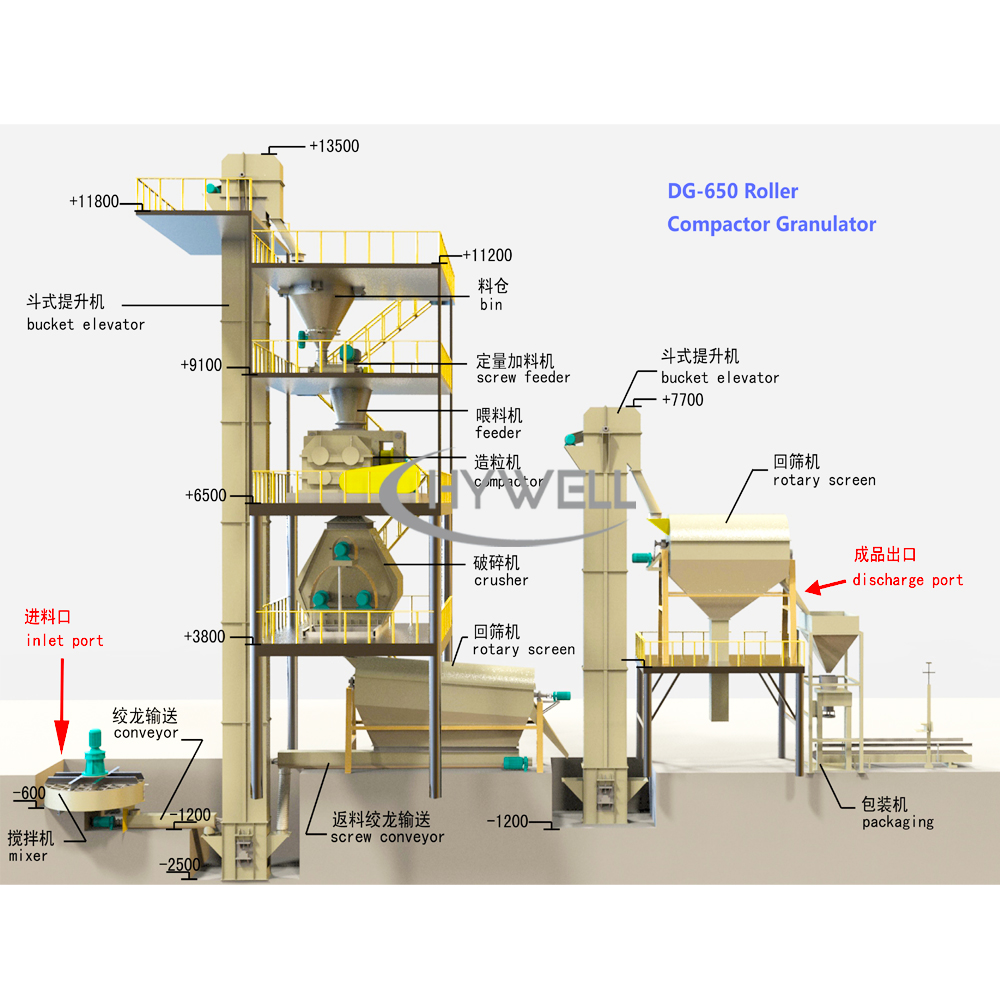
DG-650 Roller Compactor Granulator

DG-850 Roller Compactor Granulator
Roller Compactor Granulator Machine Parameter
Model | DG360 | DG450 | DG650 | DG850 |
Roller diameter(mm) | Φ360 | Φ450 | Φ650 | Φ850 |
Valid usable width(mm) | 170-230 | 200-280 | 300-330 | 400-420 |
Roller speed (r/min) | 10-25 | 10-25 | 10-25 | 9-16 |
Forced feeder power (kw) | 7.5 | 11 | 11 | 15 |
Accumulator pre-pressure (Mpa) | 6 | 8-10 | 8-10 | 10-14 |
Max rolled sheet thickness (mm) | 8 | 12 | 16 | 25 |
Rolled sheet output(t/h) | 1300-2300 | 2500-3500 | 5000-7000 | 12000-15000 |
Finished product output(t/h) | 1000-1300 | 2000-2500 | 3000-4300 | 5500-7500 |
Granular size(mm) | 2-5 | 2-5 | 2-5 | 2-5 |
Roller motor power(kw) | 37 | 55 | 90 | 220 |
Total power(kw) | 55 | 90 | 175 | 400 |
Dimensional size(m) (L*W*H) | 2.35x2x2.6 | 2.6x2.2x2.9 | 3.6x2.8x3.2 | 5x3.8x4.1 |
Total weight (T) | 7 | 11 | 20 | 45 |

Roller
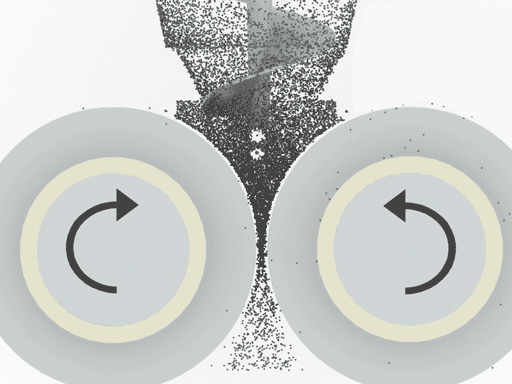
Roller Granulator

Roller
Working principle of dry compactor granulation equipment
Various dry powder materials are evenly fed into the feeding hopper through the quantitative feeder. After degassing and spiraling pre-pressure, they enter two equal rollers. The rollers rotate relative to each other and the materials are forced into the space between the two rollers. One set of roller-bearing seats is in the machine. The frame does not move, while the other set of roller-bearing seats swims on the frame guide rails and is pressed against each other with the help of hydraulic cylinders. There are many holes of the same shape and size regularly arranged on the surface of the roll. At this time, the dry powdery material enters between the two rollers continuously and evenly from above the two rollers by its own weight and forced feeding. The material first flows freely, and then is rolled after entering the bite area. With the continuous rotation of the roller, the space occupied by the material gradually decreases and is gradually compressed, reaching the maximum forming pressure. The stripped finger-shaped clumps enter the granulator and are crushed by the rotating knife. The crushed materials enter the granulator and pass through the rolling knife, so that the particles and some powdery materials enter the rotary vibrating screen for screening. Qualified products are sent to the finished product warehouse via a conveyor. The powdery material under the screen is sent back to the raw material bin again through the conveyor for secondary rolling. The size of the extrusion force can be adjusted by the pressure of the hydraulic cylinder according to the needs of the granulation operation.
Roller Compaction Granulator Features
1. The material is forced to be compressed and molded by mechanical pressure without adding any wetting agent, and the purity of the product is guaranteed.
2. The dry powder is directly granulated without a subsequent drying process.
3. The granules have high strength and the increase in stacking specific gravity is more significant than other granulation methods.
4. It has great operating flexibility and wide adaptability. The particle strength can be adjusted through hydraulic pressure.
5. The system operates in a closed cycle to achieve continuous production.
6. Change the groove form of the roller surface to obtain sheet, strip, and flat spherical materials.
7. Circular operation enables continuous production and high output of finished products;
8. Compact structure, convenient maintenance, simple operation, short process flow, low energy consumption, high efficiency and low failure rate.
9. It can control environmental pollution, reduce powder waste and packaging costs, and improve product transportation capabilities.
10. The feeding and feeding device adopts variable frequency stepless adjustment control. It has a high degree of automation and can realize multi-machine control by one person. It has the characteristics of low labor intensity and long-term continuous operation.
11. The main transmission components are made of high-quality alloy materials. The production of stainless steel materials and other surface alloys greatly improves wear resistance, corrosion resistance, high temperature resistance, and pressure resistance, giving the machine a long service life.
Roller Compactor Dry Granulator Working Process flow
This chapter mainly introduces the process flow of our company's double-roller granulator. In fact, we mainly divide the dry granulator into a single unit roller granulator process line and a complete line project of multiple roller granulation machine . In the following articles, we introduce different types of process flows separately.

Single-unit roller granulator process line
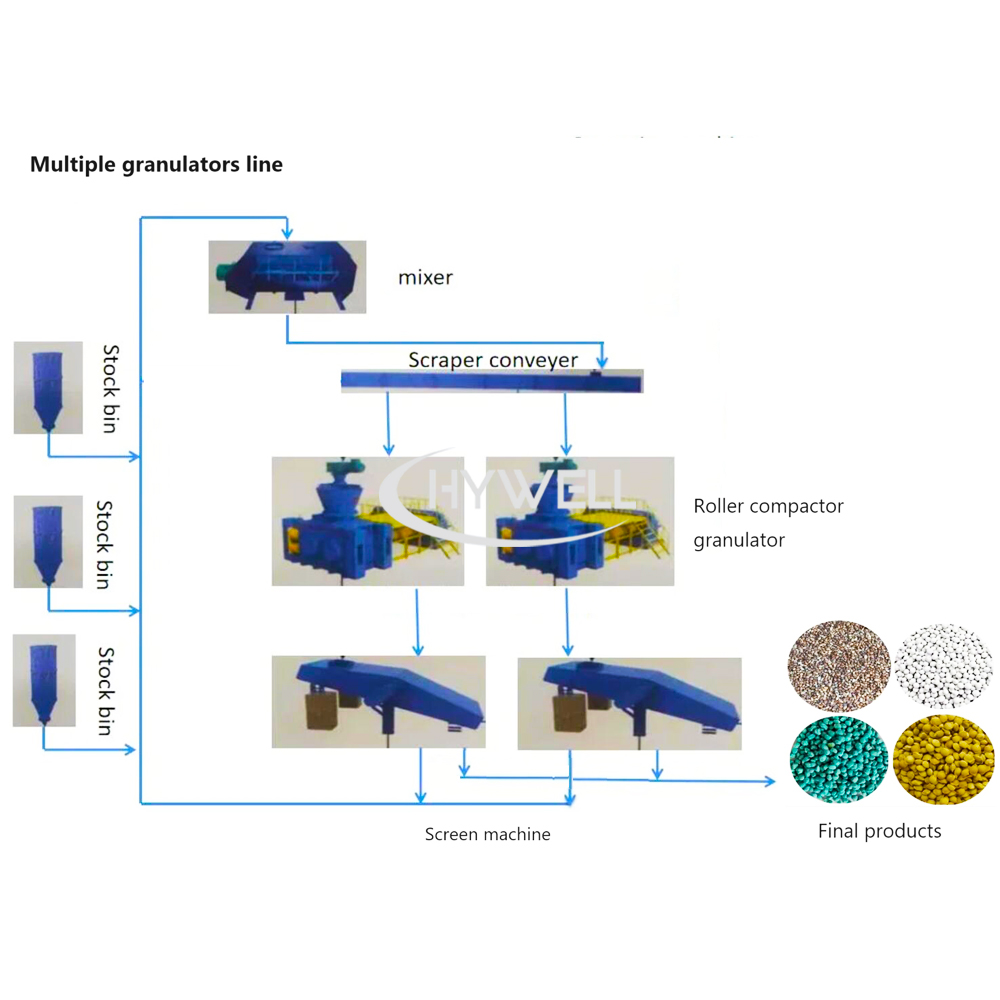
Multiple roller granulation machine process line
Single-unit roller granulator process line
1. Pre-feeding hopper
A feeding hopper with mechanical vibration, automatic control, and timing vibration.
2. Quantitative feeder
it adopts variable frequency speed regulation to ensure feeding accuracy.
3. Forced feeding spiral hopper
It is composed of a variable frequency speed motor, a conical spiral, a conical hopper with stirring blades, and a feeding port combination. Its function is to further complete degassing and perform pressure feeding. Degassing is to make the particles more compact by the roller compactor granulating machine,
4. Flaking mill
It consists of left and right fixed bearing seats and sliding bearing seats, frame structure, two alloy steel rollers, two hydraulic cylinders, and an electric automatic pump station, as well as a special reducer with hard tooth surface and the main motor unit.
5. Crushing and granulating machine
The crushing and granulating chamber of a dry-type roller press granulator is composed of a chopping box, a chopping spindle, and a special rotating blade. The motor drives the main shaft to rotate at a high speed to crush the extruded materials into granules.
6. Vibrating grading screen
Equipped with an anti-clogging device to facilitate cleaning of the screen. The broken powder from the crusher is screened by the machine into granular products and recycled powder.
7. Return auger
Unqualified powdery materials are transported to the feeding elevator.
8. Bucket elevator
The upper and lower sprockets adopt an assembled structure and are used to transport materials.
9. Electric control cabinet
It is composed of an electric control box, frequency conversion speed controller, ammeter, voltmeter, indicator light, button switch, voltage conversion switch, and other electrical components. All electrical appliances are controlled and operated centrally.
The production process of a complete set of double-roller extrusion granulation production line equipment generally includes:
Mixing and stirring of raw materials → crushing - extrusion - screening - electronic quantitative packaging.
Multiple roller granulation machine process line
Take the granular potassium sulfate production line with the DG-650 granulator as the core as an example.
1. Feed the production line according to different proportions of materials through belt flow scales, spiral flow scales, loss-in-weight scales, and other batching devices;
2. The materials entering the production line in a fixed proportion enter the preheated drum dryer through conveyor equipment such as belt conveyors, undergo preliminary drying, and then enter the next step (this step is determined according to the moisture content of the specific materials. Some materials do not require this drying equipment); because the mixing of different materials is also achieved during the drying process of the drum dryer. If the moisture content of the material is low and the drying process is not required, a powder mixer needs to be added to mix the different materials evenly before proceeding to the next step.
3. After preliminary drying, the materials or materials from the powder mixer enter the dry roller tableting machine through conveyor equipment such as scraper bucket elevators for tableting;
4. The physical form of the material after entering the slicing has changed. At this time, the material is sent to the next process, the vibrating screen, through conveying equipment such as bucket elevators. After the material enters the vibrating screen, the powdery material will be returned to the DG650 dry roller pressing machine again through the return scraper and re-sheeted. At the same time, the materials that have been successfully pasted enter the next process;
5. The flaky materials coming out of the vibrating screen enter the impact crusher for crushing;
6. The crushed materials are sent to the next process, a coarse rotary screen, through conveying equipment such as scrapers and bucket elevators. In this process, a preliminary screening is performed to select materials of suitable size and enter the next process. , at the same time, materials with relatively large sizes enter the return scraper and then enter the impact crusher for secondary crushing;
7. The materials with a suitable volume initially screened by the rotary screen enter the fine-grade rotary screen through the scraper. Through this process, the too-small particles in the material are screened out and sent to the DG650 again through the return scraper. Re-banding in the dry roller bonding machine;
8. At this time, the volume size of the material is relatively in line with the size we need. It enters the transfer polishing machine through belts, bucket elevators, and other equipment to polish the surface of the material particles;
9. The polished particles (mixed with polished powder in the middle) enter the sieve for fine screening. After passing the fine screening process, the granular material that comes out is the required granular potassium sulfate fertilizer and is sieved by the fine screen at the same time. The removed powder enters the front-end DG-650 dry roller tableting machine again through the return scraper and is re-pelletized;
10. The granular material coming out of the fine screen is the final product. At this time, it needs to enter the packaging machine for bag packaging and sewing;
11. After potassium sulfate is packaged, it enters the last process of robot palletizing. Through the palletizing robot, the materials produced by the production line are neatly packaged on the pallet, and then put into storage by forklift;
The above process is basically a fully automatic production line for granular potassium sulfate fertilizer. The control system of this production line is completely integrated and is uniformly operated and controlled by the master control system in the central control room. The control system is controlled by a programmable The controller (PLC) controls the entire process, and is equipped with a host computer as the carrier for human-machine exchange. At the same time, the necessary process links are equipped with frequency converters for dynamic adjustment, ultimately enabling the entire production line to achieve optimal production efficiency;
Advantages of the multiple dry type granulator project process line
Advanced power system
The use of an enlarged double-shaft output special reducer and drum coupling can effectively protect the rollers and main bearings from damage, improve the transmission efficiency, and further increase the product output.
Optimized rack structure
The new frame, designed with optimized calculations based on ergonomics, is equipped with a large door structure close to the rollers and a top working platform that is convenient for personnel to operate, fully meeting customer requirements for equipment safety, reliability, and convenient maintenance.
Efficient and durable alloy steel rollers
The roll body of the fertilizer granulating machine is integrally forged from high-quality alloy steel and is widely adaptable to various complex material conditions. In the design of the wear-resistant layer on the roller surface, we mastered the law of the depth of large mechanical stress based on Hertzian contact theory and pure elasticity theory, and scientifically combined the materials of the anti-tear layer, transition layer, and wear-resistant layer, as well as the hardness Improvements in matching and heat treatment processes have greatly improved the anti-cracking and wear resistance of the roll surface. The roller surface pattern, which was finalized after repeated tests and comparisons and benefited from the technical improvements of other components (such as the feeding device), can make the material pull-in angle more balanced and stable, and at the same time effectively eliminate the axial force of the roller. Make the equipment work more stable.
New design feeding device
The newly designed feeding device is equipped with an adjusting valve plate, which can easily realize online adjustment. The addition of an air expansion chamber can smoothly discharge the air entrained in the material and improve the bite of the material between the rollers. The technical improvement of the feeding device has also directly led to the improvement of the roller surface pattern.
Simple and safe hydraulic system
In the design of the hydraulic system of the potassium sulfate granulating machine, Hywell not only considers it as a power source but also makes it have the function of protecting the equipment. Multiple automatic protection functions are designed, and the optimized hydraulic system makes the moving roller more adaptable to movement, which can effectively eliminate accidentally mixed iron pieces and protect the safe operation of the equipment.
Efficient granulator system
The crusher of the potassium chloride granulator is divided into two stages, which can crush the block materials pressed by the sheet twice. It has three crushing chambers, which greatly increases the crushing area. Therefore, the crusher effectively improves the crushing efficiency and yield.
Superior screening system
This machine has the advantages of small vibration, low noise, and low requirements for the strength of the support. It combines the advantages of circular motion, elliptical motion, and reciprocating linear motion. It is also equipped with a screen surface cleaning device, so the machine has large output and high screening efficiency. High, low power consumption, flexible installation, and easy screen replacement.
New intelligent control method
The frequency converter that controls the quantitative feeder and the roller press forms a closed-loop control system between them. In this way, the granulator control system itself will monitor and control the quantitative feeder and roller press through the PID of the frequency converter itself. The speed of the main machine allows the two to maintain a dynamic working balance at the best position at all times so that the working current of the roller press main machine is always maintained at the set working value and works stably and evenly. At the same time, the forced feeding can also make slight adjustments to the speed at any time. As a result, the roller granulator is always in the best working condition. At the same time, this system also has mutual switching between manual control and automatic control modes to achieve flexible and convenient operation.
English
Русский
العربية
Français
Español
Português
Deutsch
italiano
日本語
한국어
Nederlands
Tiếng Việt
ไทย
Polski
Türkçe
ພາສາລາວ
Bahasa Melayu
Filipino
Bahasa Indonesia
magyar
Română
Čeština
қазақ
Српски
हिन्दी
فارسی
Slovenčina
Slovenščina
Norsk
Svenska
українська
Ελληνικά
Suomi
Հայերեն
עברית
Dansk
اردو
বাংলা
Hrvatski
Afrikaans
Gaeilge
Eesti keel
Māori
नेपाली
Oʻzbekcha
latviešu
Azərbaycan dili
Беларуская мова
Български
ქართული
Kurdî
Кыргызча

 简体中文
简体中文